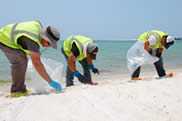DEEPWATER HORIZON RESPONSE: Gulf of Mexico Oil Cleanup
Health Hazard Evaluation
Health Hazard Evaluation of Deepwater Horizon Response Workers: Final Report
Summarizes evaluations made during the course of the offshore and onshore HHE investigations and describes the conditions and characteristics encountered during the event.
NIOSH Efforts to Protect Oil Cleanup Workers

NIOSH protected oil cleanup workers with the following efforts:
- Partnered with the Occupational Safety and Health Administration (OSHA) and National Institute of Environmental Health Sciences (NIEHS) to provide other federal and state partners, BP, and workers with guidance and educational materials for protecting response workers.
- Conducted health hazard evaluations and surveillance of reported illnesses among workers involved in the Gulf response.
- Developed a voluntary roster of workers to obtain a record of those who have participated and a mechanism to contact them about possible work-related symptoms of illness or injury, as needed.
- Analyzed injury and illness data provided to NIOSH by BP safety officials to increase awareness of the risks associated with Gulf oil response work.
NIOSH research scientists are currently conducting toxicology studies on the dispersant used in the Deepwater Horizon response (Nalco Corexit 9500A), crude oil, and dispersant and crude oil mixtures. These chemicals and chemical mixtures are being tested for possible adverse health effects of pulmonary and dermal exposure. The information from these studies will help NIOSH and others develop recommendations for protecting workers from the potential effects of these chemicals and chemical mixtures. When completed, the results of these studies will be made available to the scientific community and the general public.
NIOSH/OSHA Deepwater Horizon Guidance for Workers
Resources
NIOSH Guidance
- Chemical Exposure Assessment Considerations for Use in Evaluating Deepwater Horizon Response Workers and Volunteers
- Health Hazard Evaluation of Deepwater Horizon Response Workers: Interim Reports
- Managing Traumatic Incident Stress for Deepwater Horizon Response and Volunteer Workers
- Medical Pre-Placement Evaluation of Deepwater Horizon Response Workers
- Medical Pre-Placement Evaluation Indicators for Health Professionals
- NIOSH/OSHA Interim Guidance for Protecting Deepwater Horizon Response Workers and Volunteers
- Protecting Workers and Volunteers Responding On-Shore to Hurricanes from the Gulf of Mexico
- Reducing Occupational Exposures while Working with Dispersants During the Gulf Oil Spill Response
Other NIOSH Resources
- A Decision Process for Determining Whether to Conduct Responder Health Research Following Large Disasters
- Health Hazard Evaluation of Deepwater Horizon Response Workers
- Health Hazard Evaluation Report on the Exxon/Valdez Alaska Oil Spill
-
Lessons Learned from the Deepwater Horizon Response
DHHS (NIOSH) Publication No. 2012-117 -
Managing Your Stress: Tips for Deepwater Horizon Response and Volunteer Workers
DHHS (NIOSH) Publication No. 2010-155 - NIOSH Interim Respiratory Protection Recommendations for Deepwater Horizon Response Workers
- NIOSH Presentation at the Institute of Medicine Gulf of Mexico Oil Spill Workshop: Response of the Federal Government to Health Issues
- Potential Hazards to Deepwater Horizon Response Workers
- Protecting Workers in Large-Scale Emergency Responses: NIOSH Experience in the Deepwater Horizon Response
- Recommendations for Biomonitoring of Emergency Responders: Focus on Occupational Health Investigations and Occupational Health Research
- Review of the OSHA-NIOSH Response to the Deepwater Horizon Oil Spill: Protecting the Health and Safety of Cleanup Workers
- Science Blog: NIOSH's Role in the Deepwater Horizon Response
- Tips for Deepwater Horizon Workers
Hazard Information
All Hazards
Benzene
Chemical Dispersants
Chemical Hazards
Fatigue
Fuel Oils
Heat Stress
Hurricanes
Mosquitoes
Poisonous Plants
Respiratory Protection
Snakes
Stinging Insects
Stress
Sun Exposure
Other Government Resources
- HHS Safety and Training of Oil Spill Response Workers and Volunteers
- CDC 2010 Gulf of Mexico Oil Spill
- OSHA: Keeping Workers Safe During Oil Spill Response and Cleanup Operations
- National Institute of Environmental Health Sciences (NIEHS): Oil Spill Emergency Response and Cleanup
- Deepwater Horizon Unified Command Information
- EPA Response to BP Spill in the Gulf of Mexico http://www.epa.gov/bpspill
- NOAA Responds to the Deepwater Horizon/BP Oil Spill
- National Library of Medicine Crude Oil Spills and Human Health Resources
- U.S. Fish and Wildlife Service Deepwater Horizon Oil Spill Response http://www.fws.gov/home/dhoilspill/
- U.S. Government Restore the Gulf
Selected Publications
- Page last reviewed: February 4, 2011
- Page last updated: June 17, 2014
- Content source:
- National Institute for Occupational Safety and Health Office of the Director


 ShareCompartir
ShareCompartir